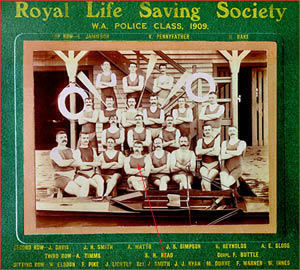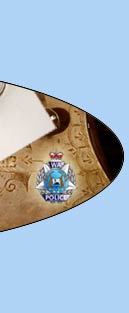|
(The following account appeared in the Police News in 1962 and is repeated to honour the memory of one of our notable members)
In 1909, the late Inspector J. Smith, then a Sergeant, in the WA Police Force, convened a meeting of swimming enthusiasts to form what is known today as the life-saving movement.
Inspector Smith was the first honorary instructor to the West Australian Surf Life-Saving Association and his efforts were largely responsible for the number of efficient instructors who followed his steps.
In commemoration of that and other similar humanitarian services which he rendered, a memorial, in the form of a drinking fountain was erected in front of the Cottesloe bathing pavilion by donations from the Royal Life-Saving Society of Western Australia, the West Australian Amateur Swimming Association, The WA Surf Life-Saving Association, The St.John Ambulance Association, The WA Police Union, and the Municipality of Cottesloe. The memorial bears tablets carrying the names of those bodies, and was designed by Constable Doug Cummings.
In the presence of a large crowd the memorial was unveiled by the Governor (Sir William Campion) on a Sunday afternoon in 1931.
 The Governor was attended by Colonel Byron, and was received by the Mayor (Mr. R. Wilkes) and representatives of the bodies concerned. Mr F. Curran, of the Royal Life-Saving Society, said that the occasion was one on which honour was to be done to the memory of the man who was really responsible for the establishment of Life-Saving in the State, and had done more for the movement than any other individual.
The Governor was attended by Colonel Byron, and was received by the Mayor (Mr. R. Wilkes) and representatives of the bodies concerned. Mr F. Curran, of the Royal Life-Saving Society, said that the occasion was one on which honour was to be done to the memory of the man who was really responsible for the establishment of Life-Saving in the State, and had done more for the movement than any other individual.
Mr Curran paid a tribute to Mr. C. Bader, whose energy and enthusiasm, he said had made the erection of the memorial and the accompanying ceremony possible.
Appreciation of the late Inspector Smith's work as an organiser and honorary instructor to the West Australian Swimming Association was expressed by Mr J.P.Sheedy and Sergeant Robinson, representing the Police Union, referred to the late Inspector Smith as a very dear comrade of his fellow members of the Force.
The President of the West Australian Surf Life-Saving Association ( Mr I.T. Birtwistle) said that the association was proud to associate itself with the ceremony. In 1909 Inspector Smith, with a few enthusiasts of similar mind, had considered that it was time that efforts were made to prevent loss of life at the beaches. Assisted by Major Sanders, he drew up a system of drill, which was now regarded as crude, and a few primitive reels appeared at the Cottesloie beach. From those small beginnings had grown the Surf Life-Saving Association, now an active and valuable service to the public.
"The late Inspector Smith was a man wonderfully good in every act for the benefit of his fellows." Said Dr Tymms, of the St. John Ambulance Association. He had devoted a great deal of his time to such work, none of which, he thought, was more valuable than that of first aid to the injured. The late Inspector Smith seemed to have an inspiration in his life, and his every act was unselfish.
It was fitting, said Sir William Campion, that a representative of the King should be associated with the ceremony, and he considered it an honour and a privilege to be present to commemorate the name of the late Inspector Smith. Coming from England to Western Australia, he had been impressed by many things, particularly by the fact that nearly everybody in the State could swim. Nothing had impressed him more than the efficiency of the life-savers he had seen in action, and the fact that many bathers owed their safety, and sometimes their lives, to the voluntary work of the various life-saving organisations. The source from which those organisations had emanated in this State was the man whose memory was being honoured. His was a life devoted to public service.
During 33 years service in the Police Force he voluntarily gave of his best to prevent suffering, and it was a striking commentary on the value of his work that 90 per cent of the Force held certificates for first aid. It was hoped that those who saw the memorial would realise that the humanity which the late Inspector Smith extended to his fellow beings was symbolised in it. It was in a way pleasant that his association with the ceremony was one of the last services which he should perform as Governor of the State.
The Mayor of Cottesloe (Mr R. Wilkes) In moving a vote of thanks to Sir William Campion for his attendance at the ceremony, said that he had always thrown himself heartily into activities for the benefit of the State. The Council had readily agreed to maintain the memorial and provide it with water, and he accepted it on behalf of the municipality. The late Inspector Smith would have been fully deserving of the memorial had he done nothing else than to start the movement which had given the State such a fine body of young men and women, who, as members of the life-Saving clubs, made the beaches safe for the bathers by the application of efficient methods.
At the conclusion of the ceremony a display was given at Cottesloe main beach by representatives of the various bodies, showing the progress made since the inception of the movement in the work of the saving of life from drowning. Members of the Royal Life-Saving Society and the Police Union rescued patients by methods of 1909, and a demonstration of surf life-saving under alarm reel conditions was given by members of clubs of the Surf Life-saving Association. Although necessarily brief, the display provided a striking illustration of the value of the work, and also of the fact that the movement started by the late Inspector Smith, although possibly crude at its inception, has grown into an efficient and extremely valuable public service.
Recently (1962), the City of Cottesloe made an approach to all interested organisations to make available finance to repair and maintain this memorial.
The Police Union gladly contributed the sum of £50.00 towards such a fund and the City of Cottesloe, the Surf Life-Saving Association and the Royal Life Saving Society have all agreed to make available a similar amount.
The Police Union is pleased to identify itself with this memorial to the late Inspector J. Smith, one of our early members, whose foresight started the life saving movement as we know it today. Life saving has often been quoted as the only amateur sport of today, in that it's members obtain no remuneration whatever, but unselfishly give time and money to the saving of life.
It will be pleasing to all members of the Force that this memorial will no longer fall into disrepair, but be maintained to perpetuate Inspector Smith's memory.
(Editors note: Inspector John Smith regimental number 110 served from October 1893 until November 17, 1926 when he died whilst serving as the Officer In Charge of the traffic Branch to which he had been appointed in January 1920. The establishment of this post followed the Police take-over of traffic in the metropolitan area. In 1907 he had obtained permission from the Governor to use the term 'Royal' when describing the life saving classes he ran for members of the Police Force.)
|













